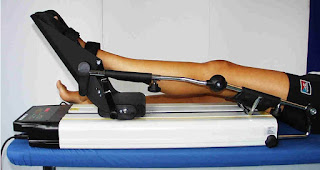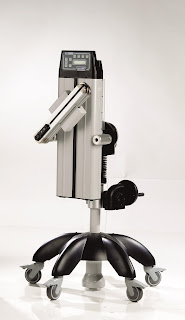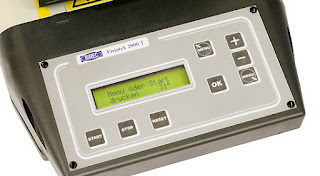After several months of design, Rimec has introduced on the market a new line of 5 CPM models for passive rehabilitation, which represent the core business of the company.
This article want to give practical information about the models and their features, with the aim to provide valid support both to the professionals and to the patients.
In order to collect all the basic information on models, we propose you the following chart:
 |
| Technical chart Fisiotek 3000 series (*) with the provided button (**) with a menu's page |
Some general considerations about Fisiotek 3000 series:
- it's composed of 5 models, 3 of them (3000 GS - 3000 G - 3000 E) with the new frame's structure, and the remaining 2 of them (3000 TS - 3000 N) have manteined the structure of Fisiotek 2000 line;
- it has been improved with a new programming software, which is set up on all the models;
- between the series, it has been preserved the model for the ankle, the TS version, which confirm its uniqueness as device able to treat all the lower limbs in a sole device;
- it's available a new accessory, the Mobile Programming keyboard, which can be used to program the features, supporting the therapist and giving the possibility to place responsibilities on patients which take part actively in the session;
Description of the models:
FISIOTEK 3000 GS -----> this model can treat the knee and the hip through the movement of flexion-extension. It is provided of Memory Card, used for patient data storage and to start the Warm Up feature (for joint heating). Reduced weight and new programmable features able to customize the rehab therapy taking care about the clinical frame of the patient.
FISIOTEK 3000 G -----> the brother of GS version, but without the Memory Card. This model has been though for professionals who need to follow the patient during the rehabilitative process after surgical or not surgical pathologies.
FISIOTEK 3000 E -----> one of the two simplest models of the series, particulary suggested for post-operative rehabilitation where is necessary to recover the mobility quickly. Apart from the basic features (ROM adjustement, speed, force, time of work), this model has one of the two new features introduced, the "repetitions" to flexion and extension limit, which are particulary used in order to strengthen the reaching of limit fixed.
FISIOTEK 3000 TS -----> the sole model present on the market in terms of technical features and structure: the 3000 TS version can treat knee, hip and ankle, combining versatility and uniqueness ever obtained by a CPM. This model is built with the old structure of Fisiotek 2000 line (the weight increases up to 14kg.), the same asimmetrical frame but the new programming software set up. It's provided of Memory Card for patient data storage and for the Warm Up.
In the picture above, the dorsal flexion of the ankle.
Is it also possible to see the asymmetrical frame of Fisiotek 3000 TS
FISIOTEK 3000 N -----> the second simplest model of Fisiotek 3000 series, though especially for rental activity. This model has been designed, together with TS version, with the structure of Fisiotek 2000 line, the same asymmetrical frame but with the new programming graphic enriched of self-explanatory symbols, suitable for an easy programming, even at home.

Are you interested to receive the catalog of the new Fisiotek 3000 series?
Visit our website and get in touch with us!
-------------------->Link to the website<--------------------





















































